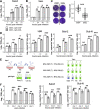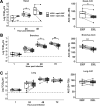Amino acid substitution L232F in non-structural protein 6 identified as a possible human-adaptive mutation in clade B MERS coronaviruses
- PMID: 38038429
- PMCID: PMC10734512
- DOI: 10.1128/jvi.01369-23
Amino acid substitution L232F in non-structural protein 6 identified as a possible human-adaptive mutation in clade B MERS coronaviruses
Abstract
Viral host adaptation plays an important role in inter-species transmission of coronaviruses and influenza viruses. Multiple human-adaptive mutations have been identified in influenza viruses but not so far in MERS-CoV that circulates widely in dromedary camels in the Arabian Peninsula leading to zoonotic transmission. Here, we analyzed clade B MERS-CoV sequences and identified an amino acid substitution L232F in nsp6 that repeatedly occurs in human MERS-CoV. Using a loss-of-function reverse genetics approach, we found the nsp6 L232F conferred increased viral replication competence in vitro, in cultures of the upper human respiratory tract ex vivo, and in lungs of mice infected in vivo. Our results showed that nsp6 L232F may be an adaptive mutation associated with zoonotic transmission of MERS-CoV. This study highlighted the capacity of MERS-CoV to adapt to transmission to humans and also the need for continued surveillance of MERS-CoV in camels.
Keywords: MERS-CoV; coronavirus; nsp6; virus evolution.
Conflict of interest statement
The authors declare no conflict of interest.
Figures







Update of
-
Mutation nsp6 L232F associated with MERS-CoV zoonotic transmission confers higher viral replication in human respiratory tract cultures ex-vivo.bioRxiv [Preprint]. 2023 Mar 28:2023.03.27.534490. doi: 10.1101/2023.03.27.534490. bioRxiv. 2023. Update in: J Virol. 2023 Dec 21;97(12):e0136923. doi: 10.1128/jvi.01369-23. PMID: 37034576 Free PMC article. Updated. Preprint.
References
-
- WHO . 2016. Prioritizing diseases for research and development in emergency contexts. Available from: https://www.who.int/activities/prioritizing-diseases-for-research-and-de...
-
- WHO . 2022. MERS situation update. Available from: https://www.emro.who.int/health-topics/mers-cov/mers-outbreaks.html
Publication types
MeSH terms
Substances
Grants and funding
LinkOut - more resources
Full Text Sources
Research Materials

